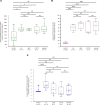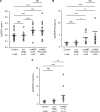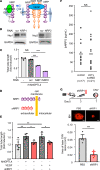ANGPTL4 influences the therapeutic response of patients with neovascular age-related macular degeneration by promoting choroidal neovascularization
- PMID: 35653189
- PMCID: PMC9310537
- DOI: 10.1172/jci.insight.157896
ANGPTL4 influences the therapeutic response of patients with neovascular age-related macular degeneration by promoting choroidal neovascularization
Abstract
Most patients with neovascular age-related macular degeneration (nvAMD), the leading cause of severe vision loss in elderly US citizens, respond inadequately to current therapies targeting a single angiogenic mediator, vascular endothelial growth factor (VEGF). Here, we report that aqueous fluid levels of a second vasoactive mediator, angiopoietin-like 4 (ANGPTL4), can help predict the response of patients with nvAMD to anti-VEGF therapies. ANGPTL4 expression was higher in patients who required monthly treatment with anti-VEGF therapies compared with patients who could be effectively treated with less-frequent injections. We further demonstrate that ANGPTL4 acts synergistically with VEGF to promote the growth and leakage of choroidal neovascular (CNV) lesions in mice. Targeting ANGPTL4 expression was as effective as targeting VEGF expression for treating CNV in mice, while simultaneously targeting both was more effective than targeting either factor alone. To help translate these findings to patients, we used a soluble receptor that binds to both VEGF and ANGPTL4 and effectively inhibited the development of CNV lesions in mice. Our findings provide an assay that can help predict the response of patients with nvAMD to anti-VEGF monotherapy and suggest that therapies targeting both ANGPTL4 and VEGF will be a more effective approach for the treatment of this blinding disease.
Keywords: Clinical practice; Molecular diagnosis; Molecular pathology; Ophthalmology.
Conflict of interest statement
Figures









Similar articles
-
VEGF inhibition increases expression of HIF-regulated angiogenic genes by the RPE limiting the response of wet AMD eyes to aflibercept.Proc Natl Acad Sci U S A. 2024 Nov 12;121(46):e2322759121. doi: 10.1073/pnas.2322759121. Epub 2024 Nov 5. Proc Natl Acad Sci U S A. 2024. PMID: 39499641 Free PMC article.
-
Aqueous proteins help predict the response of patients with neovascular age-related macular degeneration to anti-VEGF therapy.J Clin Invest. 2022 Jan 18;132(2):e144469. doi: 10.1172/JCI144469. J Clin Invest. 2022. PMID: 34874918 Free PMC article. Clinical Trial.
-
ANGIOPOIETIN-LIKE 4 CORRELATES WITH RESPONSE TO INTRAVITREAL RANIBIZUMAB INJECTIONS IN NEOVASCULAR AGE-RELATED MACULAR DEGENERATION.Retina. 2018 Mar;38(3):523-530. doi: 10.1097/IAE.0000000000001554. Retina. 2018. PMID: 28151839
-
Treatment Strategies for Anti-VEGF Resistance in Neovascular Age-Related Macular Degeneration by Targeting Arteriolar Choroidal Neovascularization.Biomolecules. 2024 Feb 21;14(3):252. doi: 10.3390/biom14030252. Biomolecules. 2024. PMID: 38540673 Free PMC article. Review.
-
Incomplete response to Anti-VEGF therapy in neovascular AMD: Exploring disease mechanisms and therapeutic opportunities.Prog Retin Eye Res. 2021 May;82:100906. doi: 10.1016/j.preteyeres.2020.100906. Epub 2020 Oct 3. Prog Retin Eye Res. 2021. PMID: 33022379 Free PMC article. Review.
Cited by
-
Targeting hypoxia-inducible factors with 32-134D safely and effectively treats diabetic eye disease in mice.J Clin Invest. 2023 Jul 3;133(13):e163290. doi: 10.1172/JCI163290. J Clin Invest. 2023. PMID: 37227777 Free PMC article.
-
Primary tumor-derived systemic nANGPTL4 inhibits metastasis.J Exp Med. 2023 Jan 2;220(1):e20202595. doi: 10.1084/jem.20202595. Epub 2022 Oct 21. J Exp Med. 2023. PMID: 36269299 Free PMC article.
-
ANGPTL4: A Comprehensive Review of 25 Years of Research.Cancers (Basel). 2025 Jul 16;17(14):2364. doi: 10.3390/cancers17142364. Cancers (Basel). 2025. PMID: 40723247 Free PMC article. Review.
-
Aflibercept more effectively weans patients with neovascular age-related macular degeneration off therapy compared with bevacizumab.J Clin Invest. 2023 Jan 17;133(2):e159125. doi: 10.1172/JCI159125. J Clin Invest. 2023. PMID: 36413411 Free PMC article.
-
Vitamin A deficiency compromises the barrier function of the retinal pigment epithelium.PNAS Nexus. 2023 May 19;2(6):pgad167. doi: 10.1093/pnasnexus/pgad167. eCollection 2023 Jun. PNAS Nexus. 2023. PMID: 37275262 Free PMC article.
References
-
- Nguyen DH, et al. Current therapeutic approaches in neovascular age-related macular degeneration. Discov Med. 2013;15(85):343–348. - PubMed
Publication types
MeSH terms
Substances
Grants and funding
LinkOut - more resources
Full Text Sources
Other Literature Sources
Medical
Molecular Biology Databases

